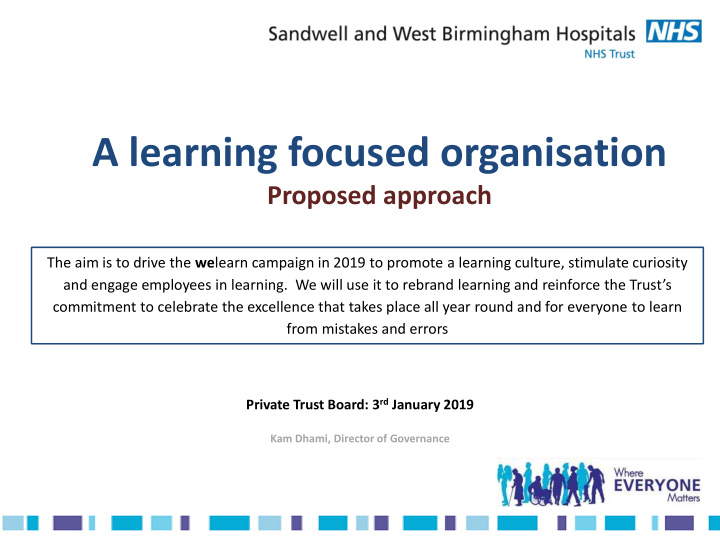



A learning focused organisation Proposed approach The aim is to drive the we learn campaign in 2019 to promote a learning culture, stimulate curiosity and engage employees in learning. We will use it to rebrand learning and reinforce the Trust’s commitment to celebrate the excellence that takes place all year round and for everyone to learn from mistakes and errors Private Trust Board: 3 rd January 2019 Kam Dhami, Director of Governance
We have tried to do this before… A three step approach 1 2 3 What should be How best should it Is it making a known? be shared? difference? Creating the Pushing and pulling Is knowledge being learning from knowledge across shared at scale and everything we the organisation in all parts of the know through and adapting the Trust, and is that systematic approach to range learning converting evaluation of learning styles into changed results Please consider which step has not worked before? 2
Creating knowledge Ensuring that what is learned locally is spread widely A drive for nurturing learning will develop a culture for learning worth shouting about. This will be helped by making learning visible to everyone, in meetings, on the intranet, in newsletters and our website. Initial ideas on ways to achieve this include: 1) The development of a learning wall to display and share pieces of learning to generate curiosity, become conversation points and foster knowledge transfer. 2) The formation of a squad of people who draw together local knowledge and intelligence from across the organisation and translate it into learning ready for wider sharing being mindful of different learning styles 3) Encouraging directorates to achieve a required number of valuable learning opportunities each month, to be known as GEMS . This visual representation will help teams to focus on whether they have identified sufficient knowledge, and also help to track which teams are actively engaged in sharing knowledge. 3
Sharing better Some existing approaches we use to learn Video reflexivity and simulation Research / quality improvement Schwartz rounds projects Grand rounds Observing peers Quality Improvement Half Days Reflective practice Journal clubs Discussion groups Learning Alerts and other policy ‘Master classes’ briefings Literature / internet searches Learning from excellence Audit and service reviews Big room Continuing education sessions Case reviews Model Hospital/GIRFT Benchmarking with other services 4
Sharing some ideas from elsewhere 1) Learn from celebrated failure : Failure is natural and it’s also natural to want to feel embarrassed or discouraged by it. Successful organisations use failure as a stepping-stone to far better things. 2) Mind mapping / Brainstorming Mind mapping and brainstorming are staple methodologies for any problem-solving activity. In these sessions, learners come up with ideas and post them on a board. As a group, colleagues then select the best ones and use those to come up with a solution. 3) Role Playing Role playing is also another effective approach founded on active learning methods. Role playing simulates real-life situation that requires problem-solving skills. More importantly, it is also a medium for gauging actual performance. Role playing activities can include job simulations like customer interaction through the phones, email, chat, or in some cases, virtual reality. 5
Sharing new: some ideas from elsewhere 4) Scavenger Hunts Here is another fun and engaging activity that involves the use of the organisation’s knowledge base. Scavenger hunts start off with a ‘customer’ concern. The learner’s task is to use the system and find the appropriate resource to address the issue. Not only does it familiarize the learners with the system, but it also prepares them to handle real-life scenarios. 5) Push it Good: When content is pushed it is given to colleagues at the right time and in places where the learner will use it. 6) Pull it Back: One of the easiest and best ways to empower the workforce to learn and organise on their own is to make sure resources are managed and accessible at all times. Create an archive and ensure that employees know how to use it and gain access to it . • Create Learning Opportunities : With a collected database employees from different departments can expand their knowledge base, giving them opportunities to grow and become more informed for their own sake and the company. • Reduce Scheduling Conflicts : By giving employees the tools to self-teach this can do away with the scheduling nightmares that can arise when doing mandatory group sessions. • Refresh: It can be difficult, if not impossible to learn everything in one or two sessions. Having 24/7 access leverages employees’ natural way of learning and allows them to look back at the material as needed. 6
Making it work – and making a difference Impact – to be developed further… Quantity/scale • Assessed through longitudinal Directorates to be encouraged to study of both audit results and achieve a count of 25 valuable staff/patient feedback learning GEMS in a year. • Reduction in observed errors and Core attendance expected of improvement in always event individuals at portfolio of learning delivery events • Increase in employees reporting Volume of posters and articles that the Trust is committed to published by directorates to form learning in surveys part of performance review and evaluation Achieve 150 QIHD Posters in 2020 contest 7
Recommend
More recommend